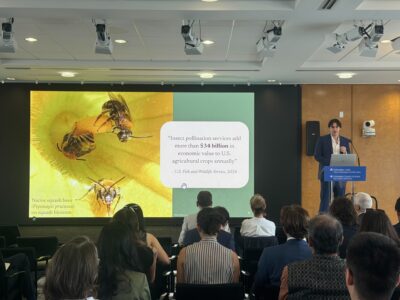
In a career that has already spanned the roles of farmer and corporate sustainability professional with ARAMARK; current MPA in Environmental Science and Policy (MPA-ESP) student Kendall Singleton knows that her niche in the sustainability sector lies in designing and implementing sustainable food systems. As her time in the MPA-ESP program comes to a close, Kendall will apply her project management experience and her quantitative and analytical skills to whatever role lies in store.
1. What drew you to the Master of Public Administration in Environmental Science and Policy program (MPA-ESP)?
After having worked as a sustainability coordinator in a role that became very marketing/PR focused, I realized that I wanted to create change through more than simply organizing educational campaigns and hosting ad hoc events; I wanted to instead shift the paradigm by implementing and influencing effective policies. I decided that to be in the best position to do this, I needed to gain a solid academic skill set in policy and management. I was attracted to ESP’s incorporation of sustainability and the environment into all of our coursework: for example, we take macroeconomics, but we discuss concepts like GDP and inflation in the context of natural resource extraction or absolute versus relative resource efficiency.
2. What were you doing before you started the program?
As an undergraduate at the University of Virginia, I became interested in U.Va. Dining/Aramark’s significant environmental footprint, and how that could be mitigated. What began as curious musings about the possibilities of composting and removing Styrofoam from the dining halls evolved into my launching and leading U.Va. Dining’s sustainability movement. In August 2009, a couple of years after graduation, I returned to the university as Dining’s first Sustainability Coordinator (having farmed and worked on other local sustainability projects in the meantime). This role put me in the unique position of working closely with stakeholders that spanned students, academic administrators, front-line dining employees, corporate managers, and the producers and distributors in the regional food system, in order to establish sustainability as a priority within both the university and Aramark’s Higher Education line of business.
3. What area of environmental policy and management are you most interested in?
My passion still lies in the sustainable food and agriculture sector. Specifically, I’m interested in creating local and regional supply chains that successfully incorporate more sustainable and nutritious food into institutional food systems.
4. What skills and tools do you hope to acquire through the program?
Since I don’t have a quantitative background, I gave my left brain plenty of exercise this year to beef up those quantitative skills. My goal isn’t to become a financial or accounting professional, but rather to become familiar with the concepts and jargon so that I can be conversant with the actual experts. I think it will be essential to make the business case for sustainability for it to become truly integrated into our society. Similarly, we need trained sustainability professionals in leadership roles to authentically incorporate the triple bottom line. I have gained project management experience that I hope to put to use in a leadership capacity throughout my career.

5. What is your favorite class in the MPA-ESP program so far, and why?
Without a doubt, our workshop courses each semester have challenged me and reaffirmed that environmental policy and advocacy is truly my vocation. The capstone experiences, particularly working with a client in this final semester, have made me confident that I can take on sustainability projects with short deadlines, changing priorities, and in-depth research – in short, that I can comfortably handle a typical consulting environment!
6. How has collaborating with your fellow students in class projects benefitted you professionally and personally?
Collaboration has been a defining aspect of the ESP experience. I love the international flavor of our cohort and the variety of backgrounds everyone brings to the table.
7. Beyond the classroom, what, if any, extracurricular sustainability-related activities have you engaged in with your fellow Environmental Science and Policy students?
Some of my favorite moments of the program have come from informal moments around the dinner table or at the bar where the conversation turns naturally to discussing things like sustainable development or environmental legislation. It’s just such a great and accurate reflection of how passionate and thoughtful everyone is about our course of study – we can’t help but bring it up even in our downtime.
8. How do you intend to utilize your degree from the MPA-ESP program to further your career?
The program puts a great deal of emphasis on our unique curriculum and how it overlays a rigorous scientific background on all of the policy coursework. I do think this organization has been valuable, and that I’ll be able to translate complex scientific concepts into clear and concise language that’s accessible to a general audience. The management and consulting experience I’ve gained in workshop will also inform my next steps.
Students in the MPA in Environmental Science and Policy (MPA-ESP) program enroll in a year-long, 54-credit program offered at Columbia University’s School of International and Public Affairs, in partnership with the Earth Institute. Throughout this one-year program, students are immersed in courses that combine Columbia University’s hands-on approach to teaching public policy and administration with pioneering thinking about the environment. During the summer semester, students learn the fundamentals of environmental science, while in the fall and spring semesters, they focus on the policy and economics necessary to becoming successful environmental analysts and managers. Visit our website to learn more about the program.



